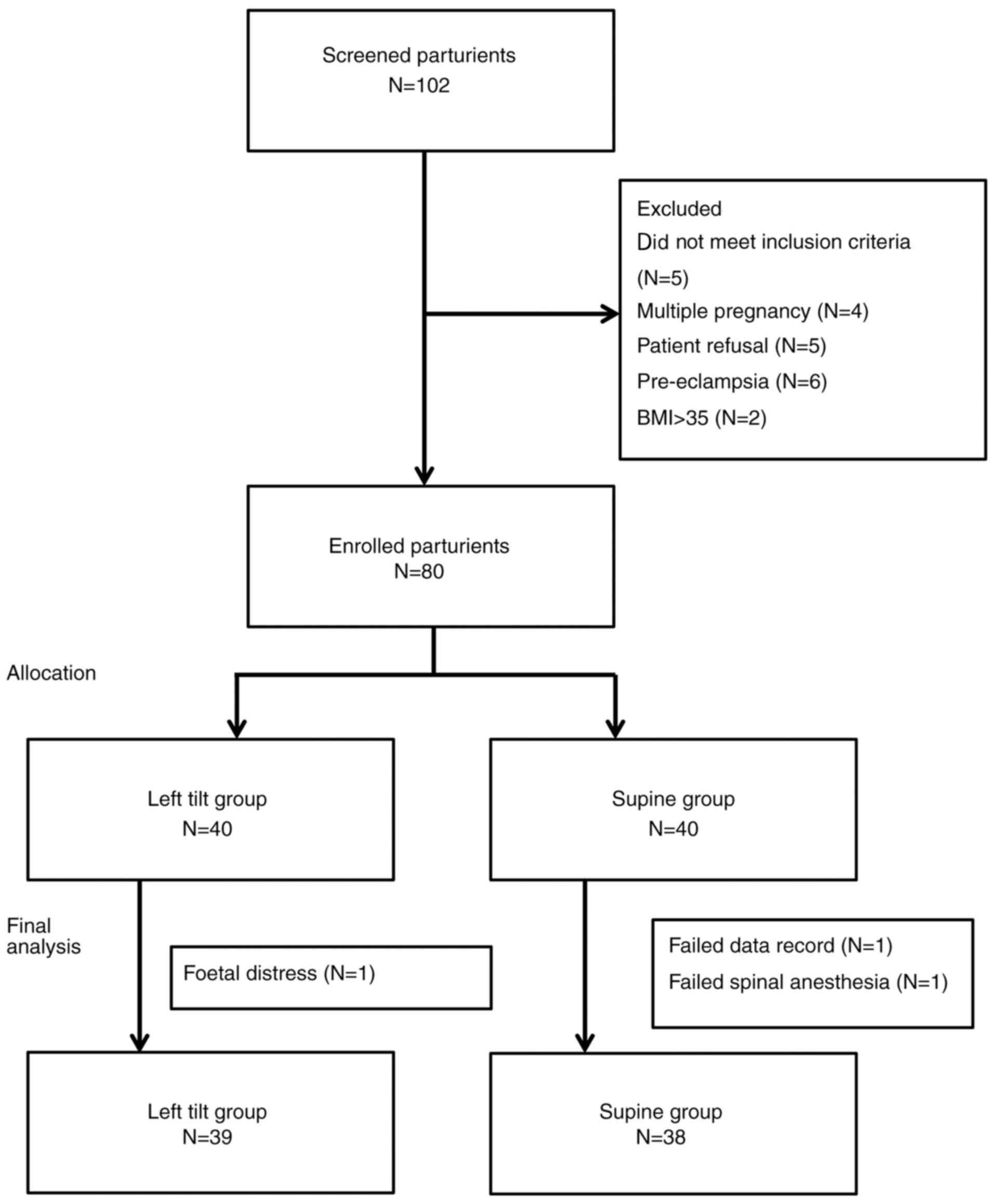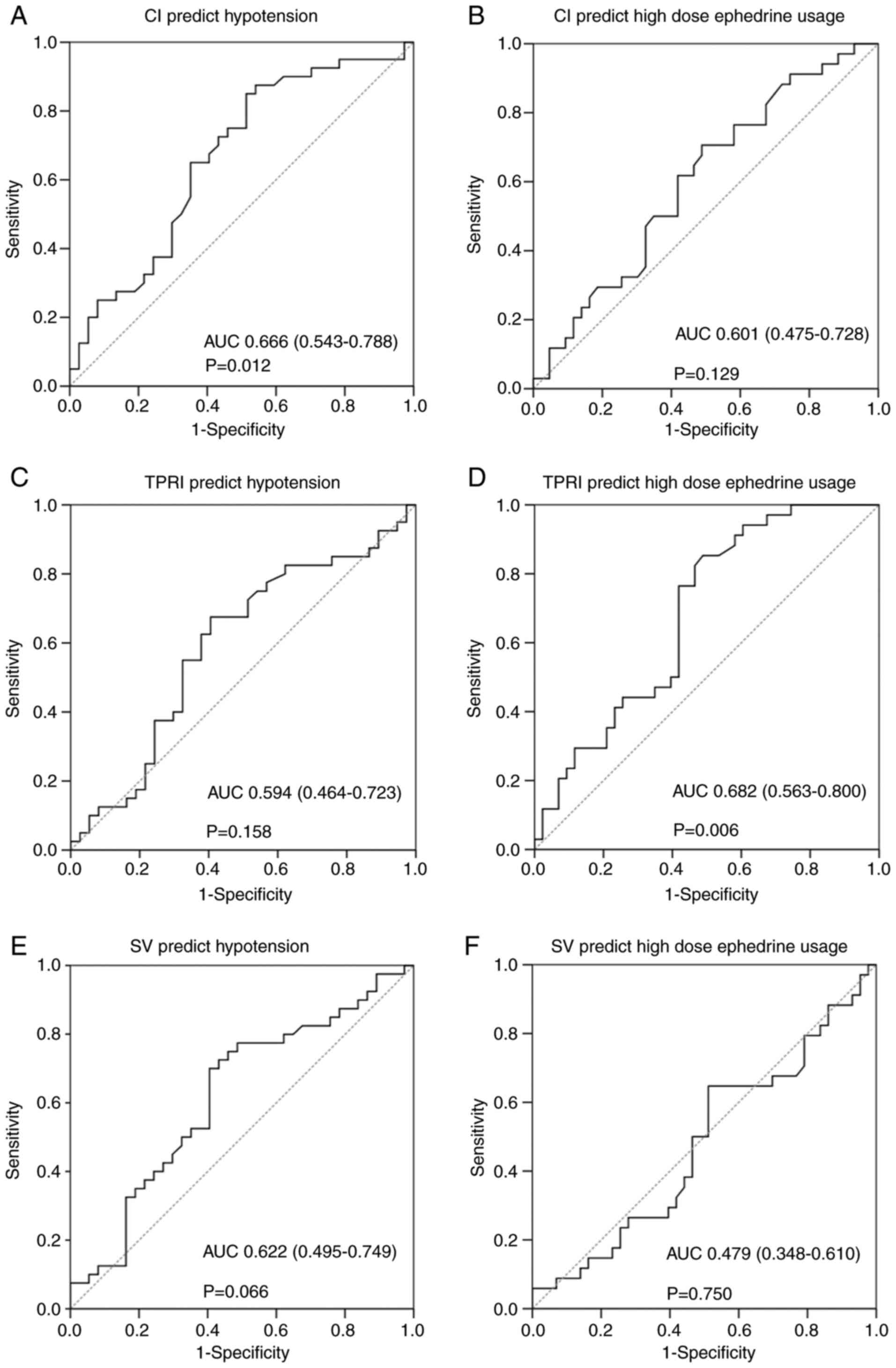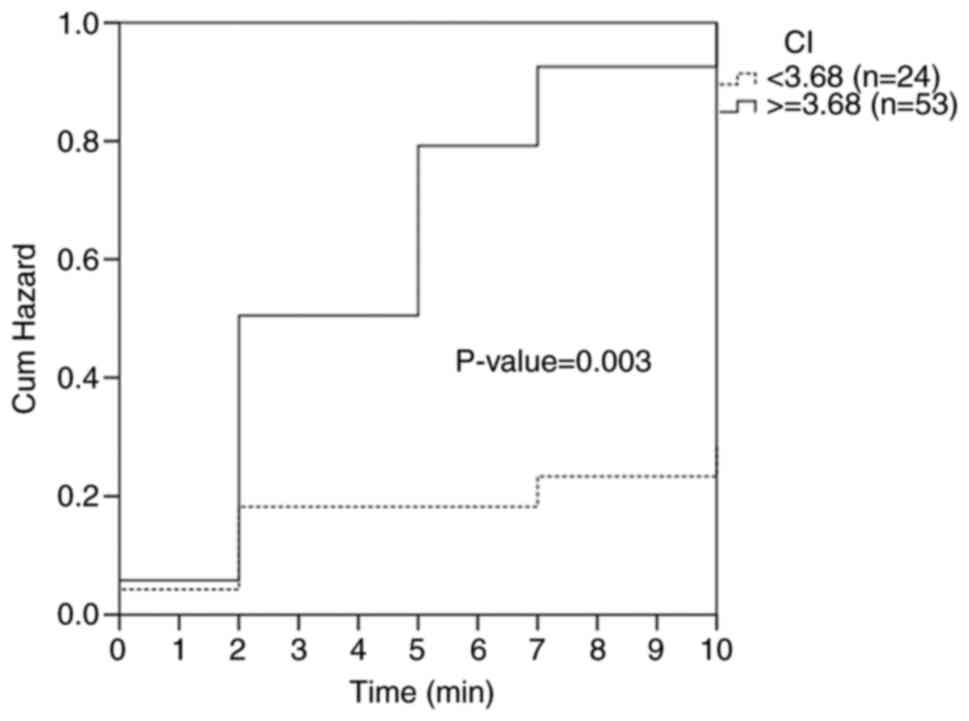|
1
|
Corke BC, Datta S, Ostheimer GW, Weiss JB
and Alper MH: Spinal anaesthesia for caesarean section. The
influence of hypotension on neonatal outcome. Anaesthesia.
37:658–62. 1982.PubMed/NCBI View Article : Google Scholar
|
|
2
|
Chooi C, Cox JJ, Lumb RS, Middleton P,
Chemali M, Emmett RS, Simmons SW and Cyna AM: Techniques for
preventing hypotension during spinal anaesthesia for caesarean
section. Cochrane Database Syst Rev. 8(CD002251)2017.PubMed/NCBI View Article : Google Scholar
|
|
3
|
Kuwata S, Suehiro K, Juri T, Tsujimoto S,
Mukai A, Tanaka K, Yamada T, Mori T and Nishikawa K: Pleth
variability index can predict spinal anaesthesia-induced
hypotension in patients undergoing caesarean delivery. Acta
Anaesthesiol Scand. 62:75–84. 2018.PubMed/NCBI View Article : Google Scholar
|
|
4
|
Bishop DG, Cairns C, Grobbelaar M and
Rodseth RN: Heart rate variability as a predictor of hypotension
following spinal for elective caesarean section: A prospective
observational study. Anaesthesia. 72:603–608. 2017.PubMed/NCBI View Article : Google Scholar
|
|
5
|
Toyama S, Kakumoto M, Morioka M, Matsuoka
K, Omatsu H, Tagaito Y, Numai T and Shimoyama M: Perfusion index
derived from a pulse oximeter can predict the incidence of
hypotension during spinal anaesthesia for Caesarean delivery. Br J
Anaesth. 111:235–241. 2013.PubMed/NCBI View Article : Google Scholar
|
|
6
|
Ledowski T, Paech MJ, Browning R, Preuss J
and Schug SA: An observational study of skin conductance monitoring
as a means of predicting hypotension from spinal anaesthesia for
caesarean delivery. Int J Obstet Anesth. 19:282–286.
2010.PubMed/NCBI View Article : Google Scholar
|
|
7
|
Zhang N, He L and Ni JX: Level of sensory
block after spinal anesthesia as a predictor of hypotension in
parturient. Medicine (Baltimore). 96(e7184)2017.PubMed/NCBI View Article : Google Scholar
|
|
8
|
Ouzounian JG, Masaki DI, Abboud TK and
Greenspoon JS: Systemic vascular resistance index determined by
thoracic electrical bioimpedance predicts the risk for maternal
hypotension during regional anesthesia for cesarean delivery. Am J
Obstet Gynecol. 174:1019–1025. 1996.PubMed/NCBI View Article : Google Scholar
|
|
9
|
Doherty A, Ohashi Y, Downey K and Carvalho
JCA: Monitoramento não invasivo baseado na biorreatância revela
instabilidade hemodinâmica significativa durante cesárea eletiva
sob raquianestesia. Rev Bras Anestesiol. 61:326–332. 2011.(In
Portugese).
|
|
10
|
Keren H, Burkhoff D and Squara P:
Evaluation of a noninvasive continuous cardiac output monitoring
system based on thoracic bioreactance. Am J Physiol Heart Circ
Physiol. 293:H583–H589. 2007.PubMed/NCBI View Article : Google Scholar
|
|
11
|
Jakovljevic DG, Trenell MI and MacGowan
GA: Bioimpedance and bioreactance methods for monitoring cardiac
output. Best Pract Res Clin Anaesthesiol. 28:381–394.
2014.PubMed/NCBI View Article : Google Scholar
|
|
12
|
Bonica JJ, Kennedy WF, Akamatsu TJ and
Gerbershagen HU: Circulatory effects of peridural block: 3. Effects
of acute blood loss. Anesthesiology. 36:219–227. 1972.PubMed/NCBI View Article : Google Scholar
|
|
13
|
Kim J and Shin W: How to do random
allocation (randomization). Clin Orthop Surg. 6:103–109.
2014.PubMed/NCBI View Article : Google Scholar
|
|
14
|
Klöhr S, Roth R, Hofmann T, Rossaint R and
Heesen M: Definitions of hypotension after spinal anaesthesia for
caesarean section: Literature search and application to
parturients. Acta Anaesthesiol Scand. 54:909–921. 2010.PubMed/NCBI View Article : Google Scholar
|
|
15
|
Duggappa DR, Lokesh MPS, Dixit A, Paul R,
Raghavendra Rao RS and Prabha P: Perfusion index as a predictor of
hypotension following spinal anaesthesia in lower segment caesarean
section. Indian J Anaesth. 61:649–654. 2017.PubMed/NCBI View Article : Google Scholar
|
|
16
|
Yokose M, Mihara T, Sugawara Y and Goto T:
The predictive ability of non-invasive haemodynamic parameters for
hypotension during caesarean section: A prospective observational
study. Anaesthesia. 70:555–562. 2015.PubMed/NCBI View Article : Google Scholar
|
|
17
|
Sun S and Huang SQ: Role of pleth
variability index for predicting hypotension after spinal
anesthesia for cesarean section. Int J Obstet Anesth. 23:324–329.
2014.PubMed/NCBI View Article : Google Scholar
|
|
18
|
Chamchad D, Arkoosh VA, Horrow JC, Buxbaum
JL, Izrailtyan I, Nakhamchik L, Hoyer D and Kresh JY: Using heart
rate variability to stratify risk of obstetric patients undergoing
spinal anesthesia. Anesth Analg. 99:1818–1821. 2004.PubMed/NCBI View Article : Google Scholar
|
|
19
|
Hanss R, Bein B, Ledowski T, Lehmkuhl M,
Ohnesorge H, Scherkl W, Steinfath M, Scholz J and Tonner PH: Heart
rate variability predicts severe hypotension after spinal
anesthesia for elective cesarean delivery. Anesthesiology.
102:1086–1093. 2005.PubMed/NCBI View Article : Google Scholar
|
|
20
|
Prashanth A, Chakravarthy M, George A,
Mayur R, Hosur R and Pargaonkar S: Sympatho-vagal balance, as
quantified by ANSindex, predicts post spinal hypotension and
vasopressor requirement in parturients undergoing lower segmental
cesarean section: A single blinded prospective observational study.
J Clin Monit Comput. 31:805–811. 2017.PubMed/NCBI View Article : Google Scholar
|
|
21
|
Engoren M and Barbee D: Comparison of
cardiac output determined by bioimpedance, thermodilution, and the
fick method. Am J Crit Care. 14:40–45. 2005.PubMed/NCBI
|
|
22
|
NICE, NIfHaCE: Clinical guidelines and
updates: Caesarean section. Available at: https://www.nice.org.uk/guidance/cg132/chapter/1-guidance.
Accessed Feb 10, 2020.
|
|
23
|
Lee AJ, Landau R, Mattingly JL, Meenan MM,
Corradini B, Wang S, Goodman SR and Smiley RM: Left lateral table
tilt for elective cesarean delivery under spinal anesthesia has no
effect on neonatal acid-base status: A randomized controlled trial.
Anesthesiology. 127:241–249. 2017.PubMed/NCBI View Article : Google Scholar
|
|
24
|
Nani FS and Torres ML: Correlation between
the body mass index (BMI) of pregnant women and the development of
hypotension after spinal anesthesia for cesarean section. Rev Bras
Anestesiol. 61:21–30. 2011.PubMed/NCBI View Article : Google Scholar
|
|
25
|
Wang HZ, Chen HW, Fan YT, Jing YL, Song XR
and She YJ: Relationship between body mass index and spread of
spinal anesthsia in pregnant women: A randomized controlled trial.
Med Sci Monit. 24:6144–6150. 2018.PubMed/NCBI View Article : Google Scholar
|
|
26
|
Gaiser R: Anesthetic considerations in the
obese parturient. Clin Obstet Gynecol. 59:193–203. 2016.PubMed/NCBI View Article : Google Scholar
|
|
27
|
Roofthooft E and Van de Velde M: Low-dose
spinal anaesthesia for Caesarean section to prevent spinal-induced
hypotension. Curr Opin Anaesthesiol. 21:259–262. 2008.PubMed/NCBI View Article : Google Scholar
|
|
28
|
Guinot PG, Bernard E, Defrancq F, Petiot
S, Majoub Y, Dupont H and Lorne E: Mini-fluid challenge predicts
fluid responsiveness during spontaneous breathing under spinal
anaesthesia: An observational study. Eur J Anaesthesiol.
32:645–649. 2015.PubMed/NCBI View Article : Google Scholar
|
|
29
|
Lee A, Ngan Kee WD and Gin T: A
dose-response meta-analysis of prophylactic intravenous ephedrine
for the prevention of hypotension during spinal anesthesia for
elective cesarean delivery. Anesth Analg. 98:483–490.
2004.PubMed/NCBI View Article : Google Scholar
|
|
30
|
Zaimis E: Vasopressor drugs and
catecholamines. Anesthesiology. 29:732–762. 1968.PubMed/NCBI View Article : Google Scholar
|
|
31
|
Alsufyani HA and Docherty JR: Direct and
indirect effects of ephedrine on heart rate and blood pressure in
vehicle-treated and sympathectomised male rats. Eur J Pharmacol.
825:34–38. 2018.PubMed/NCBI View Article : Google Scholar
|
|
32
|
Xia J, Yuan J, Lu X and Yin N: Prone
position results in enhanced pressor response to ephedrine compared
with supine position during general anesthesia. J Clin Anesth.
31:94–100. 2016.PubMed/NCBI View Article : Google Scholar
|
|
33
|
Duthie SJ, Ghosh A, Ng A and Ho PC:
Intra-operative blood loss during elective lower segment caesarean
section. Br J Obstet Gynaecol. 99:364–367. 1992.PubMed/NCBI View Article : Google Scholar
|

















